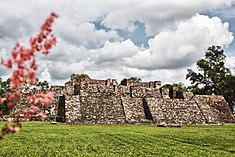
Back سقوط تينوتشيتتلان Arabic Теночтитланан гуо лацар CE Sitio de Tenochtitlan Spanish Siège de Tenochtitlan French Jatuhnya Tenochtitlan ID Caduta di Tenochtitlán Italian ტენოჩტიტლანის დაცემა Georgian Tenočtitlano žlugimas Lithuanian Падот на Теночтитлан Macedonian Beleg van Tenochtitlan Dutch
| Fall of Tenochtitlan | |||||||||
|---|---|---|---|---|---|---|---|---|---|
| Part of the Spanish conquest of the Aztec Empire | |||||||||
 "Conquista de México por Cortés". An Unknown artist, second half of the 17th century. Library of Congress, Washington, DC. | |||||||||
| |||||||||
| Belligerents | |||||||||
|
Spanish Empire (Governorate of Cuba) Confederacy of Tlaxcala Tetzcoco Otomis Chalco Mixquic Iztapalapa[1] | |||||||||
| Commanders and leaders | |||||||||
|
Hernán Cortés Gonzalo de Sandoval Pedro de Alvarado Cristóbal de Olid Xicotencatl I Xicotencatl II Chichimecatecle Ixtlilxochitl II |
Cuauhtémoc (POW) Coanacoch (POW) | ||||||||
| Strength | |||||||||
|
200,000 native allies 900–1,300 Spanish infantry 90–100 cavalry 16 cannons[2] 13 lake brigantines [2] |
80,000 warriors[3] 400 war canoes[4] | ||||||||
| Casualties and losses | |||||||||
|
450–860 Spanish[2] 20,000 Tlaxcaltecs |
100,000 killed in action[5] 300 war canoes sunk[4] At least 40,000 Aztecs civilians killed and captured,[6] other sources claim 100,000[7] to 240,000[8][9] were killed in the campaign overall including warriors and civilians | ||||||||
 |
| Aztec civilization |
|---|
| Aztec society |
| Aztec history |
The fall of Tenochtitlan, the capital of the Aztec Empire, was an important event in the Spanish conquest of the empire. It occurred in 1521 following extensive negotiations between local factions and Spanish conquistador Hernán Cortés. He was aided by La Malinche, his interpreter and companion, and by thousands of indigenous allies, especially Tlaxcaltec warriors.
Although numerous battles were fought between the Aztec Empire and the Spanish-led coalition, which was composed mainly of Tlaxcaltec men, it was the siege of Tenochtitlan that directly led to the fall of the Aztec civilization and the ensuing sacking and violence against the survivors. The indigenous population at the time was devastated due to a smallpox epidemic, which killed much of its leadership. Because smallpox had been endemic in Spain for centuries, the Spanish had developed an acquired immunity and were affected relatively little in the epidemic.
The conquest of the Aztec Empire was a critical stage in the Spanish colonization of the Americas.
- ^ Teoría de la bandera.Guido Villa.1974 "The companies portentous discovery and conquest of the New World, met under the banners of Castile incarnate". Las portentosas empresas del descubrimiento y la conquista del Nuevo Mundo, se cumplieron bajo los encarnados pendones de Castilla.
- ^ a b c Cite error: The named reference
Hassigwas invoked but never defined (see the help page). - ^ "PBS : Conquistadors – Cortés". www.pbs.org.
- ^ a b Clodfelter, Micheal (2017). Warfare and Armed Conflicts: A Statistical Encyclopedia of Casualty and Other Figures, 1492–2015 (4th ed.). McFarland. ISBN 978-1476625850.
- ^ Russell, Philip (2015). The Essential History of Mexico: From Pre-Conquest to Present. Routledge. ISBN 978-1135017217.
- ^ Paulkovich, Michael (2012). No Meek Messiah. Spillix Publishing. p. 117. ISBN 978-0988216112.
- ^ Karin Solveig Björnson, Kurt Jonassohn. Genocide and Gross Human Rights Violations: In Comparative Perspective. Transaction Publishers. p. 202. ISBN 978-0415842785.
- ^ "Victimario Histórico Militar: Capítulo IX" (in Spanish). Archived from the original on 2018-07-01.
- ^ Singer, Gabrielle (2004). A Purple Bull page 68. Vantage Press. ISBN 978-0533148356.
© MMXXIII Rich X Search. We shall prevail. All rights reserved. Rich X Search